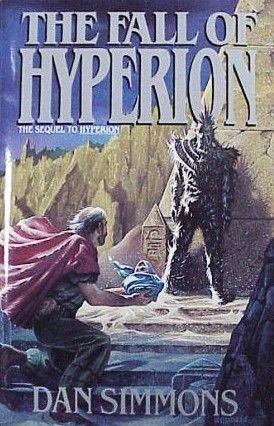A lesser light once asked Ummon //
Please deliver this learner
from darkness and illusion
quickly \\//
Ummon answered //
What is the price of
fiberplastic
in Port Romance]
– Dan Simmons in The Fall of Hyperion

Over two years ago, I ended my post about Hyperion with a note saying how unlikely it would be for its sequel to be worthy of the standards set by that excellent novel. Having stumbled across the book in a store in Kuala Lumpur and having devoured it over the course of my holiday, I am sad to report that this is indeed the case.
The Fall of Hyperion is a much more conventional space opera tale than the original was. It does away with the frame story device that made the original so memorable and tells the story in a more straightforward manner. There are now two narrative threads, one continuing the story of the six remaining pilgrims as they finally reach the Time Tombs. The other focuses on the government of the Hegemony as they respond to imminent war with the Ousters while trying their best to keep track with what is happening with the pilgrims on Hyperion.
To this end, the second thread features two new primary characters. One of them is Meina Gladstone, CEO of the Hegemony of Man, a character mentioned frequently in the first book but seen by readers for the first time in this sequel. The second character is Joseph Severn, actually another cybrid of the poet John Keats and twin to Johnny, the original Keats cybrid that was featured prominently in the story of the pilgrim Brawne Lamia. As Lamia now carries the Johnny consciousness with her in a memory implant, Severn is somehow able to see the fates of the pilgrims in his dreams and reports this information to Gladstone.
This narrative deals with the Hegemony forces moving in force to secure Hyperion and connect it to the Web via the Farcaster network. Gladstone needs to deal with not only the Ouster forces, but also rival political factions in the Hegemony itself. As the novel unfolds, it becomes clear that Gladstone knows more than she lets on and that the Technocore, ostensibly allies of the Hegemony, are up to no good.
As for the pilgrims, they are simultaneously disappointed and relieved that the Shrike does not appear to confront them immediately and settle in to wait. They do not have to wait long however as one by one, each member of the group disappears or is incapacitated due to the machinations of the mysterious Shrike.
While this novel is still a great read and Simmons’ writing is such that you always like turning the next page to see what happens, the overall effect is much diminished compared to the first book. I suppose that part of this is inevitable as like the Lost television series, it’s easy and a lot of fun to set up a mysterious situation, but it’s a lot harder to bring it to a satisfying conclusion. What’s even worse is not all the answers are clear, and while the story is continued in two more books, I don’t think I have the patience to be strung along further.
Even the plot gets hackneyed as the novel goes on and the author falls back depressingly often on deux ex machinas (even mentioning the the phrase in the text to refer to the literal god of the machines.) This includes the character of Severn, who develops increasingly useful powers for no discernible reason as well as the method by which one of the pilgrims finally defeats the Shrike.
Character development is weak too, in stark contrast with the varied and interesting stories of the pilgrims from the first book. Many pages are devoted to Gladstone and her emotional turmoil over her need to destroy the Hegemony in order to save it, but we never get the sense of really knowing what makes her tick. She’s like a Gandalf or a Dumbledore in being inscrutably wise and all-knowing, never missing a step or being truly thwarted. On the other hand, we see little of the Technocore, who are supposed all-knowing and near-omnipotent, but the little we do see turns out to be fairly unimpressive in the end. Using Zen koans to depict their speech is an interesting stylistic choice, but it doesn’t strike me that there’s anything substantial underneath the obfuscation.
As this book starts out with the Hegemony on a war footing, complete with FORCE assembling the largest fleet of warships in its history, you might expect some decent action but sadly this too is a disappointment as most of it takes place off-screen. Col. Kassad of the original pilgrim group supplies a decent amount of ground-based action but it’s nothing worth crowing about.
This means that while The Fall of Hyperion is solidly entertaining in its own right, it’s certainly no classic. In its defense, it is twenty years old, and while its tech advances are still as plausible and impressive as ever, it takes a lot more deft than this nowadays to spin an exciting science-fiction tale.